Summer Stripers in Shallow Water
Follow the simple formula: find the bait, find the fish.
Recently—meaning over the past 10 years or so—light-tackle boat fishing has dominated the inshore scene in some parts of the country, like Florida and the Gulf of Mexico. Until it gained popularity on Long Island, my angling buddies and I enjoyed a lack of competition for summer stripers. Although I fish primarily in densely populated areas like Manhasset and Little Neck bays in the western Sound, we rarely saw other boats on the fishing grounds. Boaters may be scarce, but the stripers are there and often in large numbers. These shallow estuarine areas are nursery grounds for silversides, bunker, and many young-of-the-year baitfish. By mid-summer, the waters are loaded with ½- to 1-inch baits. It’s really a simple formula: find the bait and find the fish!
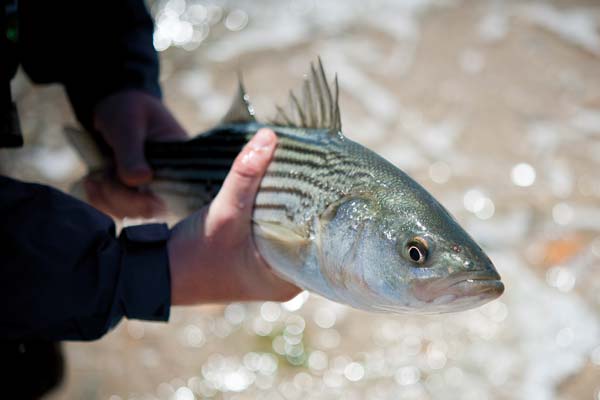
An angler can use almost any light gear and catch these stripers that are, for the most part, small. Over the years, I’ve used gear that wasn’t quite saltwater friendly and, sure enough, the tackle failed. Also, drags were often balky and required too much time for cleaning and repairing, sapping a lot of fun from the trips. That same gear didn’t seem able to handle the occasional big blue or striper. It’s nice to go light, but not at the expense of reliability and appropriate power.
(Note: On The Water is reader-supported. When you buy through links on our site, we may earn an affiliate commission.)
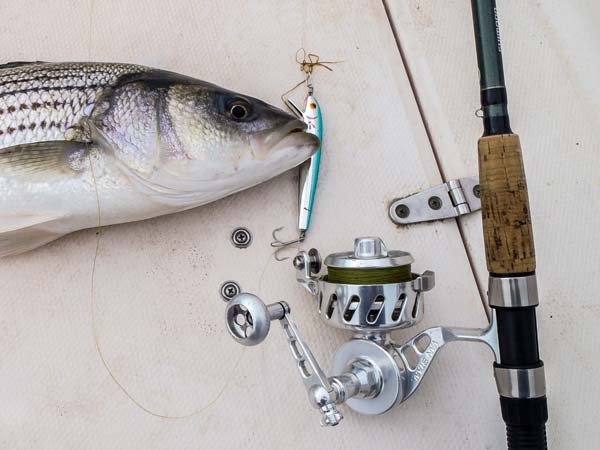
Those tackle disasters taught me a good lesson—namely, there is a limit to how light one can go. For instance, last summer I gave my standard light tackle setup to my son when stripers and large blues made an unexpected appearance, and I used a panfish rod that was earmarked for porgies. I wasn’t unprepared because our original mission statement featured porgy fishing; however, I broke that rod because of the pressure needed to manage a ten-pound blue and prevent it from tangling in moorings, the motor, and everyone else’s fish. There definitely is a limit to light!
Light Tackle for Summer Stripers
I now use a seven-foot Shimano Teramar spinning rod with a Van Staal VS150, and I spool the reel with 20-pound-test Sufix Advanced Superline Braid. The Shimano Teramar is a medium-power rod with a fast-action tip and is a solid compromise between the power needed to manage big fish and the ability to make long casts with light lures.
I also use an old baitcasting outfit that isn’t saltwater proof, but the reel has survived many years and lots of big fish. They each have an 18-inch length of 20-pound Seaguar fluorocarbon for a leader. One end is attached to the running line with a 50-pound SPRO Power Swivel that is small but provides every ounce of 50-pound test. I don’t like line-to-line knots because even the best of them fail eventually, so I tie a 75-pound-test Tactical Angler’s Power Clip on the other end of the leader.
I always use a leader because the swivel prevents line twist, the Seaguar is durable against bottom debris and teeth, and the clip allows for quick lure changes. The leader also provides safety for both the fish and me. I can lift a fish into the boat by the sturdy leader while keeping my fingers away from teeth and hooks. I also think I’m doing the fish a favor by not using a landing net. A net can remove slime that a fish produces as a protective layer against microbes and parasites.
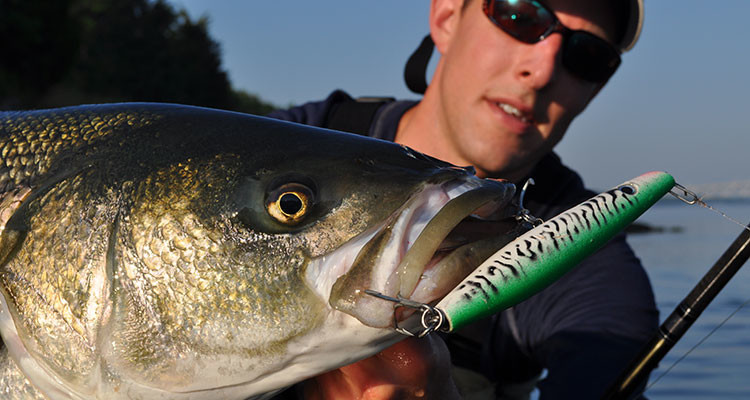
Lures for Summer Stripers
My array of lures is limited to a few styles and sizes. Since I generally cast into water that is 3 feet deep or less, my smallish lures fit into two groups: surface and light sub-surface.
Surface Lures
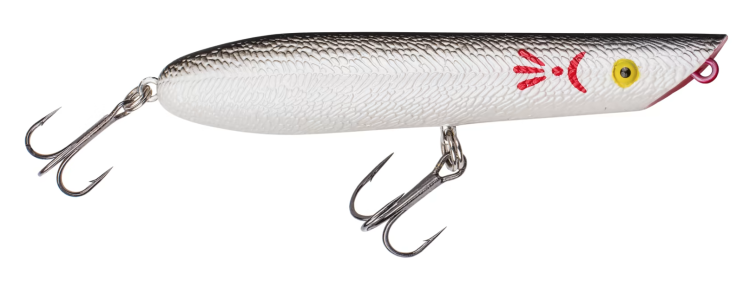
I keep surface lure choices simple: 1-ounce Cotton Cordell Pencil Poppers, 1-ounce Yo-Zuri Hydro Pencils and, when big blues are around, a 1-5/8-ounce Yo-Zuri Surface Cruiser.
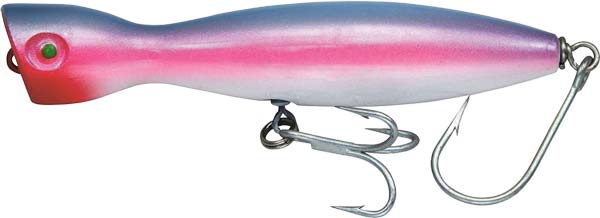
I also use Super Strike Little Neck Poppers for their ability to throw water with a steady, popping retrieve. On some days, the fish seem to want slow-moving prey, while other days they are turned on by the speed, constant motion, and exaggerated popping of a pencil.
Sub-surface Lures
My sub-surface lures are small bucktails weighing ½ to 1 ounce, and equally small jigs with soft plastics such as Z-Man DieZel MinnowZ.
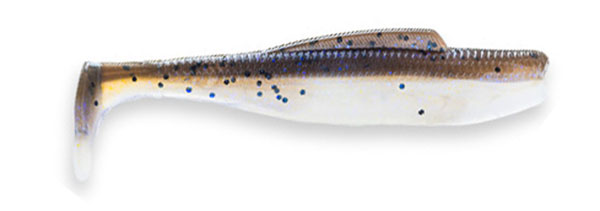
Nowadays, there are a plethora of other 3- to 5-inch soft-plastic paddletails, including the Zoom Swimmin’ Super Fluke Jr., No Live Bait Needed paddletails, and 3/8-ounce Al Gags Whip-It Fish, and they all work well. I stick with light colors such as pearl, white, white ice, and albino.
There is a caveat about soft-plastic paddletails. Some are quite soft and easily damaged, while others—like the DieZel MinnowZ— are flexible and don’t tear as easily due to their stretchy, ElaZtech construction. These 3- to 5-inch soft plastics seem to work best when the water is cold in early spring and again when baits are small in late summer. Typically, when there are significant numbers of bluefish around, the soft plastics will take a back seat to bucktails.
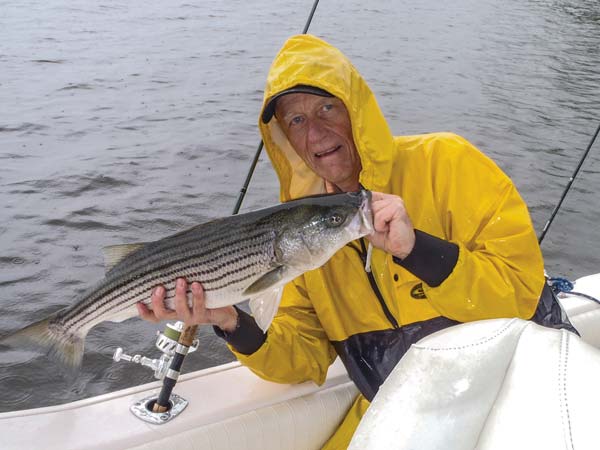
Still, even when there are no blues, I’ve found that stripers have moods—one day it’s soft plastics and the next it must be a bucktail. I don’t fight moods, but instead try to “listen” to the fish and adjust on the fly.
I use white Andrus Rip Splitter bucktails from ½-ounce to 1-ounce, and tip them with strips of Uncle Josh Sea Strips or Fat Cow Jig Strips.
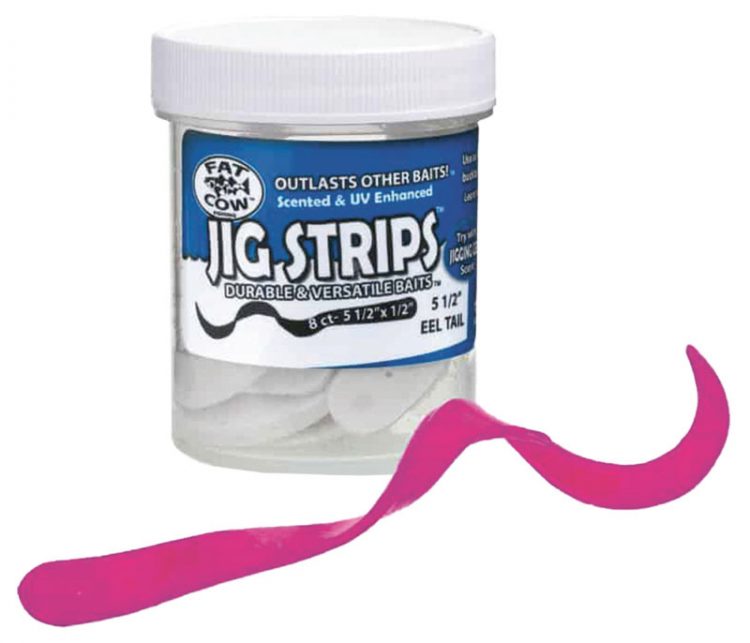
You may have to trim the rind/strips with a sharp knife to reduce both their length and width in order to achieve a better match for small bucktails. In fact, I start with a split-tail trailer and cut it across at the notch between the tails, resulting in two 3-inch strips. I use a knife tip to punch a hole in the top of each strip for the hook, and I’m ready to go. I generally prefer red and white, yellow and white, or white jig trailers.
Tides and Approach
There are always exceptions, but I’ve had more consistent success at lower tide stages, and a moment’s reflection explains why. Bait is drawn out of drains, weeds, and feeder creeks when the water column is skinny. At higher stages of the tide, most of this tiny bait is holed up in weeds and shallow pockets where the stripers can’t get at them. On the other hand, as the tide ebbs, bait come out of hiding and move to the flats where stripers can feed more economically. This may seem counter-intuitive, but moon tides that create very low tides are often best because the bait has nowhere to go; sometimes, I throw lures into a foot of water or less, and catch fish. I’m always astounded that I never see the fish in such skinny water, but they are there.
Skinny water requires precise boat handling, which may explain why so few boaters exploit this fishing. The captain must know his water and remain constantly vigilant about breezes that might push the boat aground. The few anglers that occasionally share these spaces with us tend to make serious mistakes that prevent them from catching fish.

Typically, new arrivals approach a fishing spot at high speed with lots of engine noise and push a significant wake. Whether this maneuver disturbs the bait or the fish is up for debate, but whatever the reason, the commotion chases the fish away from the boat. The second mistake occurs when a boater turns off the engine, not only because of the noise generated when the engine is restarted, but it’s also a safety issue in terms of boat control. I always leave the engine running at idle. The constant low-level noise doesn’t seem to bother fish, and when I move, I do so at idle speed, which maintains the same noise level whether moving or still. It does take a little time to move at idle speed from spot to spot, but the backs of estuaries aren’t very large, so a little patience gets you to the spot within a few minutes and does not put off the fish.
My friend Rich and I have fallen into a pattern of presentations over the years. We didn’t do this deliberately – it just happened, but works well. I prefer sub-surface lures most of the time because fish respond to them more often than surface lures. Rich, on the other hand, loves the surface explosions that come when stripers attack poppers and pencil poppers. Surface explosions are nice, but my main goal is to catch fish. Nonetheless, our differing preferences allow us to quickly discover a fish’s attitude.
There’s another advantage that we’ve discovered. We got our first hint years ago when I began casting with a small bucktail while Rich was busy retying or dealing with some boat-related issue. I made a dozen casts before he made his first cast, and I didn’t have a hit. When he made a cast, he said, “Let me wake them up with a pencil popper.” I scoffed at this, but his pencil hadn’t walked more than 10 feet before it was hit. It seems that I couldn’t catch a fish sub-surface until he had raised and caught a few fish. We’ve used that technique many times since then to stir up the troops.
This style of light-tackle fishing is about numbers, and rarely includes size, save for the odd days when big blues are on the prowl. Therefore, success is measured in quantity, and we usually catch 30 to 60 fish between the two of us. On one particular day, though, we caught over a hundred fish, and probably could have caught two hundred, except someone (who will remain nameless) got bored catching fish. Can you imagine being bored catching fish? Bored is not part of my lexicon because I never tire of fooling the fish, feeling the hit, and enjoying the idea of making contact with a wild, free-roaming creature.
Many of these places are short on structure, and when you do find some, it isn’t dramatic. For example, most bays and harbors have channels with flats on the sides. Stripers love to hunt in very shallow water, but they also like to hunt around edges. Although there may not be dramatic depth differences between the flats and channels, these changes represent edges that fish patrol. In Long Island Sound harbors, there are also places with scattered rock groins, large docks, and scattered glacial boulders. These structures attract bait that in turn attract stripers. Sometimes, when the stripers are sitting quietly on the bottom, tight to the structure waiting for food, we make our first casts close to the piece.
Rich and I have learned not to spend too much time in one area. A half-dozen good casts tells us all we need to know. If there’s bait in the back, we know the fish will be somewhere, so we move on. When we find a hot location where the fish are staying with the bait, small position adjustments are often all that’s needed to keep us on the fish.
Related Content
9 on “Summer Stripers in Shallow Water”
-
Cory margand 20 lb test is light? Thats heavy for me.
-
Greg W (That’s heavy for me)
Unless ur trying for a tip it world record, 20 is the way to go. Any one who has enjoyed light tackle for enough time, knows you occasionally come across big fish. You can land a 50pound bass on 20 playing the drag correctly.
Fussing around with 10 or 12 in back bays at the end of the day is just not worth it. The lightest I’ll go on fly and spinning gear is 20.
-
-
Dwayne Harper enjoys read about catching stripbass
-
Ramon Bobea Lots of great useful information I’m glad you took the time to write this article.
Very grateful, will love it if you can incorporate a video on rigs, rods, techniques, etc. -
Raymond D. Ross, Jr. Great Article. Good Info.
-
George Gustafson Nice article, thanks for writing it. Good info for this rookie.
-
Pat Maloney Really a Van Staal for light tackle fishing? Seems unnecessary. Lots of good info. in the article but suggest a reel for the average person, not something that costs $500+.
-
Matt Easy, just get a Striper Ugly Stik.
-
-
Evan Anyone having any luck on the flats in Barnstable this time of year?! Thinking of heading out this weekend (night).
Leave a Reply